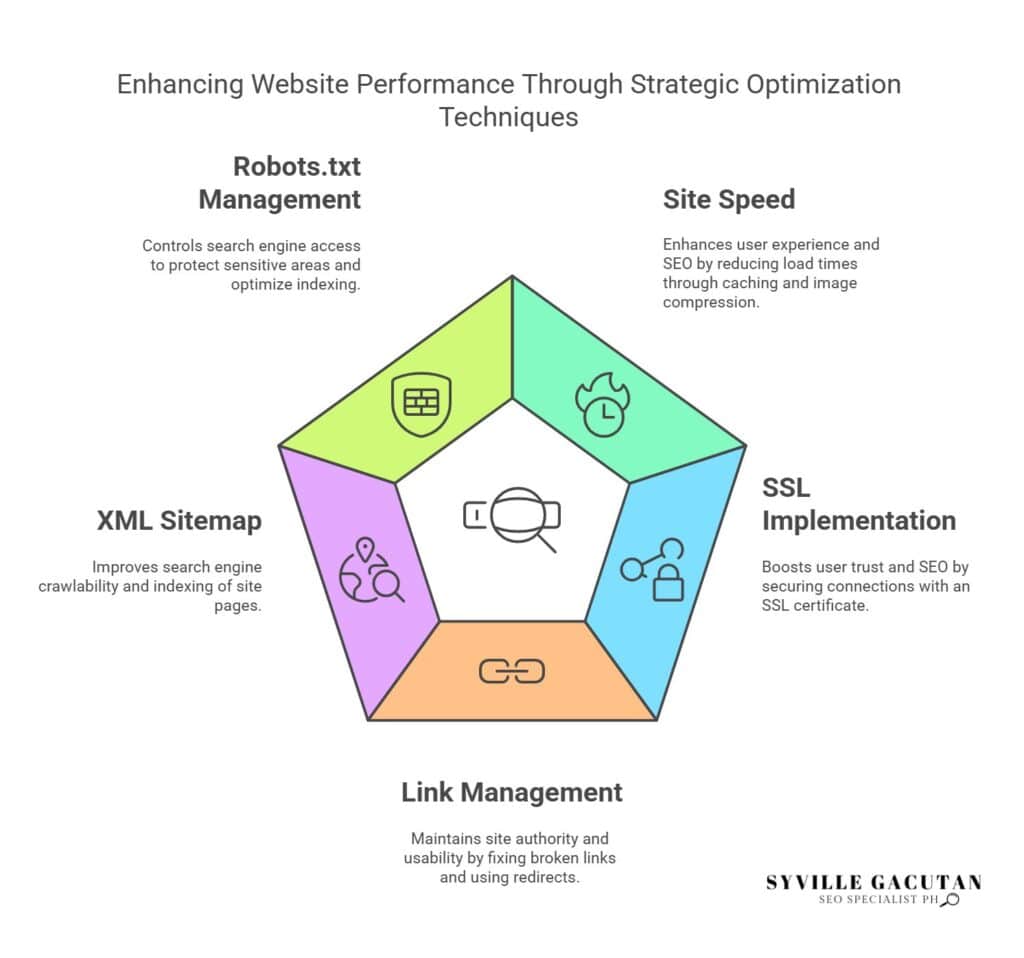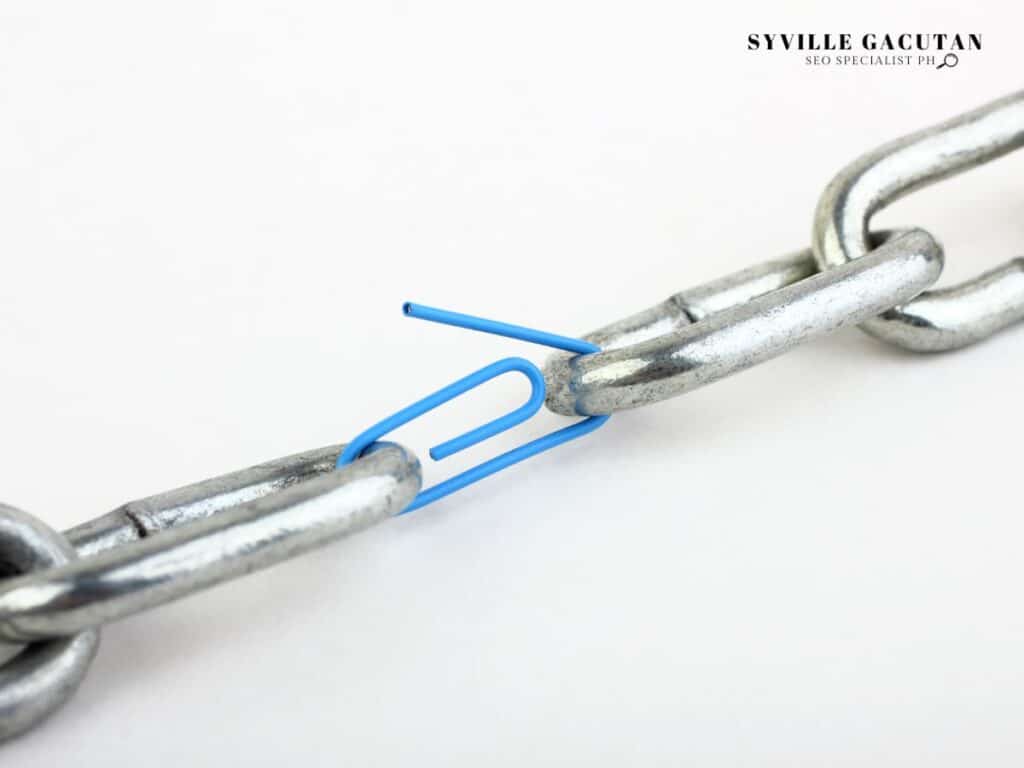
To jumpstart your technical SEO journey, prioritize optimizing site speed through methods like browser caching and minimizing HTTP requests. Implement an SSL certificate to ensure secure connections and build user trust. Regularly resolve broken links using SEO audit tools to maintain content integrity and user experience. Create and optimize an XML sitemap to improve site crawlability and indexing efficiency. Lastly, manage your robots.txt file to control search engine access and prevent indexing of low-value pages. By mastering these best practices for technical SEO beginners, you’ll establish a strong technical SEO foundation, preparing you for more advanced strategies down the line.
Key Takeaways
- Optimize site speed by utilizing browser caching, reducing HTTP requests, and compressing images.
- Implement an SSL certificate to ensure secure HTTPS connections, boosting user trust and SEO performance.
- Regularly fix broken links using tools like Google Search Console, and apply 301 redirects for moved pages to maintain link equity.
- Create and optimize an XML sitemap to enhance the crawlability and indexing of your site’s pages by search engines.
- Consistently update and monitor the robots.txt file to manage search engine access and prevent the indexing of sensitive or irrelevant areas.

1. Optimize Site Speed

Improving the speed of your website is very important for providing a good experience to visitors and also for ranking higher in search engines. Website speed has become a key factor that search engines like Google consider when deciding how to rank websites. Optimizing your website’s speed can bring many benefits. To effectively make your site faster consider the following technical tips for search engine optimization (SEO), especially if you are new to this area.
Firstly, leverage browser caching to store static resources on a visitor’s device. By doing so, returning visitors experience faster load times as the browser fetches resources locally rather than from a server. This technical aspect not only boosts page speed but also enhances user engagement.
Secondly, minimize HTTP requests by reducing the number of elements on your page, such as scripts, images, and CSS files. Combine multiple CSS and JavaScript files when possible, and use CSS sprites to consolidate multiple images into a single file. This reduction in HTTP requests can drastically improve loading times, which is a crucial technical aspect of your SEO strategy.
Additionally, optimize images to reduce their file size without compromising quality. Utilize formats like WebP or compressed JPEGs and PNGs. Implementing responsive images that adjust based on the user’s device can further enhance page speed.
Another technical SEO tip is to enable compression using Gzip, which reduces the size of HTML, CSS, and JavaScript files sent over the network. This optimization technique is particularly effective for enhancing load speed and improving your site’s overall performance.
2. Implement SSL Certificate
Securing your website with an SSL certificate is a crucial technical SEO practice that should not be overlooked. An SSL (Secure Sockets Layer) certificate ensures that the data transmitted between a user’s browser and your website is encrypted and secure. This not only protects sensitive information but also signals to search engines like Google that your site is trustworthy, which can positively impact your search rankings.
To implement an SSL certificate, you will need to obtain one from a reputable certificate authority (CA). Many web hosting providers offer SSL certificates as part of their services, often for free or at a minimal cost. Once you acquire the certificate, it must be correctly installed on your server. This process involves updating your website’s configuration to use HTTPS instead of HTTP, ensuring that all pages and resources are securely served.
From a technical SEO best practices perspective, having an SSL certificate is non-negotiable. Google has explicitly stated that HTTPS is a ranking factor, and websites without SSL certificates are often flagged as “Not Secure” in browsers, which can deter users from engaging with your website content.
Additionally, an SSL certificate can enhance user trust and credibility, essential factors for maintaining and growing your audience. Moreover, implementing an SSL certificate can prevent man-in-the-middle attacks and other security vulnerabilities, ensuring the integrity of your website content.
Regularly check the status of your SSL certificate to ensure it remains up-to-date and properly configured. In summary, securing your website with an SSL certificate is fundamental to both your site’s security and its search engine optimization efforts.
3. Fix Broken Links

Fixing broken links is a critical component of maintaining a well-optimized website for both user experience and search engine performance.
Broken links not only frustrate users but also signify technical SEO issues that can negatively impact your site’s crawl and index efficiency. Conducting regular SEO audits to identify and rectify these broken links is essential for adhering to SEO best practices.
To effectively manage broken links, consider the following steps:
- Conduct Regular SEO Audits: Use tools like Screaming Frog, Ahrefs, or Google Search Console to identify broken links. Regular audits help keep your site optimized and user-friendly.
- Use 301 Redirects: When a page is permanently moved or deleted, use 301 redirects to guide users and search engines to the correct or updated page. This ensures that the link equity is preserved.
- Update Internal Links: Ensure that all internal links point to existing pages. This not only improves user navigation but also helps search engines crawl and index your site more efficiently.
- Monitor External Links: External links can also break over time. Periodically check and update these links to maintain the credibility and authority of your content.
- Fix or Remove Broken Links: Once identified, either fix the broken links if possible or remove them. This action prevents users from encountering 404 errors and enhances the overall user experience.
Incorporating these steps into your routine SEO maintenance can significantly improve the health of your website.
4. Create XML Sitemap

After addressing broken links, another fundamental aspect of technical SEO is the creation of an XML sitemap. An XML sitemap serves as a roadmap for search engines, helping them efficiently crawl and index the pages of your website. This tool is essential for optimization and can positively influence your search engine ranking by ensuring that all significant pages are discoverable.
Creating an XML sitemap involves listing all the URLs of your site, along with additional metadata about each URL, such as when it was last updated and how frequently it changes. This metadata provides search engines with critical information that aids in the efficient and effective indexing of your site.
Benefits of an XML Sitemap
| Benefit | Description |
| Improved Crawlability | Helps search engines discover pages that might not be easily found through the site’s internal linking structure. |
| Better Indexing | Ensures that all important pages are indexed, which is crucial for ranking in search engine results. |
| Enhanced Updates | Search engines can prioritize recent updates to your site, improving the timeliness of your content in search results. |
| Comprehensive Coverage | Provides a complete list of pages, including those that might be isolated from the main navigation, ensuring broad visibility and ranking. |
To create an XML sitemap, you can utilize various tools such as Google’s XML Sitemaps Generator or plugins like Yoast SEO for WordPress sites. Once generated, submit your sitemap to search engines using tools like Google Search Console to help search engines understand your site structure better, thereby boosting optimization efforts.
5. Optimize Robots.txt

Optimizing your website’s robots.txt file is a critical step in technical SEO that can significantly influence how search engines interact with your site. This small but powerful text file instructs search engine bots on how to crawl and index various pages of your website.
Properly configuring your robots.txt file can ensure that search engines understand which pages should be indexed and which should not, making it a cornerstone of technical SEO basics.
To effectively optimize your website’s robots.txt file, consider the following essential practices:
- Allow Important Pages: Ensure that crucial pages, such as your homepage and key landing pages, are accessible to search engine bots. Blocking these pages can negatively impact your site’s visibility.
- Disallow Duplicate Content: Use the robots.txt file to prevent search engines from indexing duplicate content. This helps avoid potential penalties and maintains the integrity of your site’s SEO.
- Block Sensitive Directories: Protect sensitive areas of your site, such as login pages or admin panels, from being crawled and indexed. This not only secures your site but also conserves crawl budget.
- Monitor Crawl Errors: Regularly check Google’s Search Console for any crawl errors related to your robots.txt file. This ensures that search engines are following your directives correctly.
- Keep It Simple: A concise and clear robots.txt file is easier for search engines to interpret. Avoid overly complex rules that might lead to unintended crawling issues.
Final Thoughts
Mastering the basics of technical SEO is essential for any website owner looking to improve search engine rankings and user experience. By focusing on key areas like site speed, SSL implementation, fixing broken links, creating an XML sitemap, and optimizing your robots.txt file, you build a strong foundation for long-term SEO success. Regularly reviewing and refining these elements will help ensure your website remains optimized for both search engines and users, ultimately driving better visibility and performance.
If you’re ready to take your technical SEO strategy to the next level, connect with Syville Gacutan, an experienced SEO Specialist in the Philippines. Syville can help you optimize your website’s technical aspects, enhance its performance, and boost your search engine rankings. Don’t miss the opportunity to strengthen your online presence—reach out today!